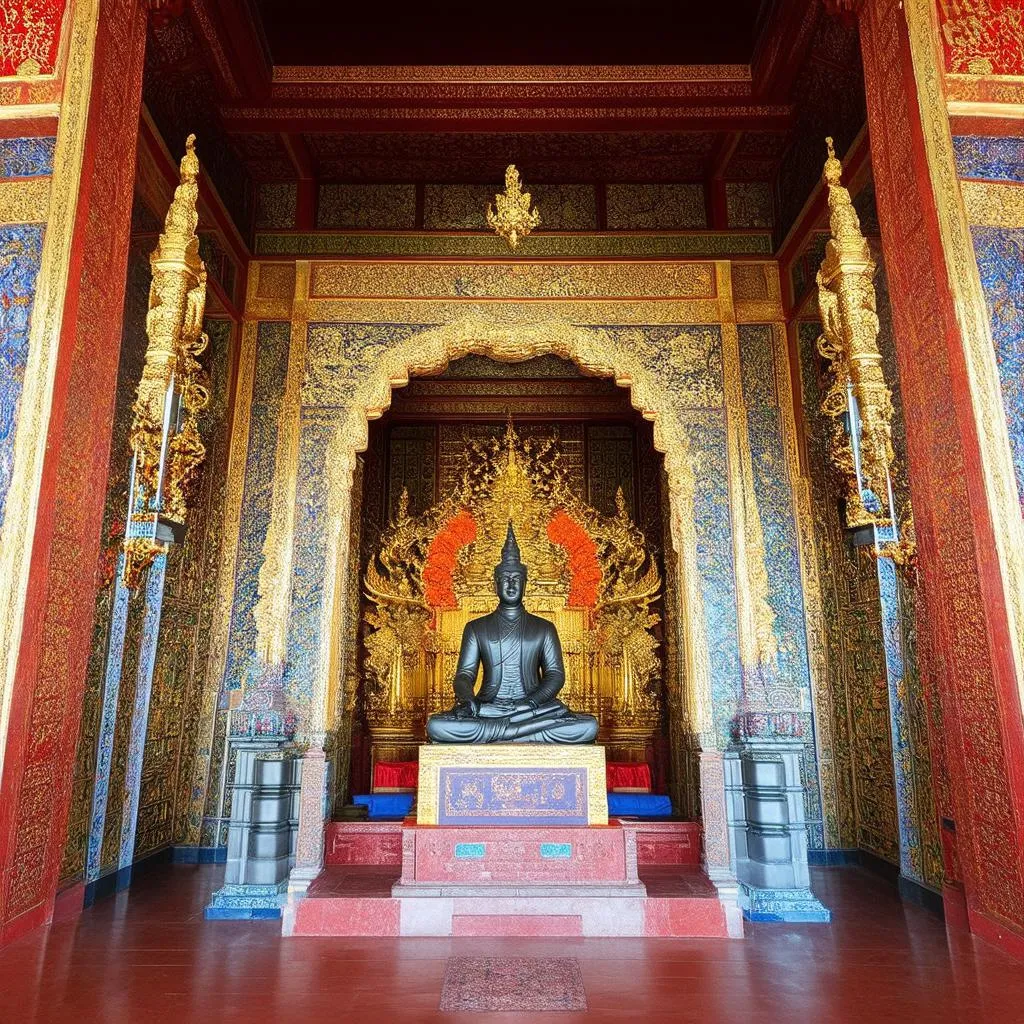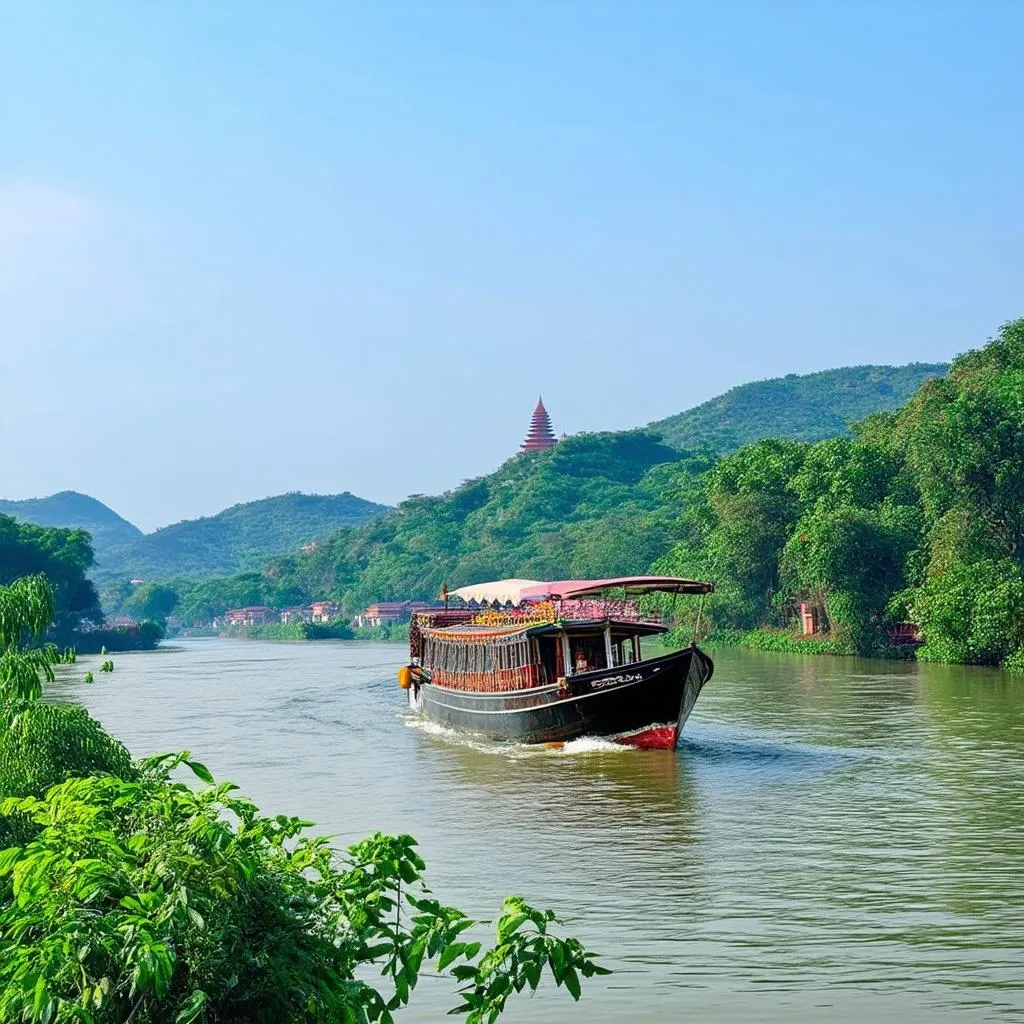Have you ever wondered what it would be like to step into a world where East meets West in a breathtaking fusion of architectural grandeur? Nestled amidst the lush hills of Chau Chu mountain in Hue, Vietnam, lies the Khai Dinh Tomb, a testament to the opulent reign of Vietnam’s Nguyen Dynasty. This isn’t just a tomb; it’s a story etched in stone, a poem of artistry and history waiting to be explored.
Khai Dinh Tomb: A Symphony in Stone and Glass
The Khai Dinh Tomb, constructed over eleven years (1920-1931), is a striking departure from the traditional Vietnamese architectural style. Imagine walking through an intricately designed courtyard, the air thick with the scent of frangipani, and suddenly being greeted by a magnificent palace that seems to have sprung from the pages of a European fairytale.
This architectural marvel, a blend of Vietnamese craftsmanship and European influences, is divided into a series of ornate halls and courtyards, each telling a story of its own.
The Stele Pavilion: A Gatekeeper of History
Our journey begins at the Stele Pavilion, guarded by imposing stone figures of mandarins and soldiers, frozen in time. Here, a giant stele, etched with the life story of Emperor Khai Dinh, stands tall, a silent narrator of a bygone era.
The Court of Honor: Where Art Reigns Supreme
As you step into the Court of Honor, prepare to be mesmerized. The courtyard, flanked by vibrant dragon-shaped balustrades, leads to the main palace – Thien Dinh. The walls, adorned with intricate mosaics made from broken ceramic and glass pieces, shimmer under the Vietnamese sun, painting a thousand stories on their surface.
Thien Dinh Palace: A Glimpse into Imperial Life
Step inside Thien Dinh, and you’ll be transported into a world of imperial opulence. The interior is a riot of color and detail. Murals depicting scenes from Vietnamese mythology and everyday life adorn the walls, while the ceiling, a breathtaking mosaic of dragons, shimmers like a thousand stars. The central highlight is the majestic bronze statue of Emperor Khai Dinh, forever enshrined in his opulent resting place.
 Khai Dinh Tomb Interior
Khai Dinh Tomb Interior
Planning Your Visit to Khai Dinh Tomb
How to Get There
Khai Dinh Tomb is located about 10 kilometers from Hue City center. You can easily reach the tomb by taxi, motorbike, or join a guided tour. For a more immersive experience, consider renting a bicycle and enjoying the scenic route along the Perfume River.
Entrance Fees and Opening Hours
The entrance fee to Khai Dinh Tomb is VND 100,000 (around USD 4.50) per person. The tomb is open daily from 8:00 am to 5:30 pm.
What to Wear
Remember to dress respectfully when visiting the tomb, as it’s a place of historical and cultural significance. Avoid revealing clothing and opt for comfortable shoes, as there’s a fair bit of walking involved.
Khai Dinh Tomb: FAQs
Q: What is the best time to visit Khai Dinh Tomb?
A: The best time to visit Hue, and therefore the tomb, is during the dry season, from February to August, when the weather is pleasant for outdoor exploration.
Q: Are there any guided tours available?
A: Yes, numerous tour operators in Hue offer guided tours to Khai Dinh Tomb, providing valuable insights into the history and architecture of the site.
Q: Is photography allowed inside the tomb?
A: While photography is generally allowed, using flash photography inside the tomb is prohibited to protect the fragile artwork.
Beyond the Tomb: Exploring Hue’s Rich Tapestry
Don’t limit your Hue adventure to Khai Dinh Tomb alone. The city is a treasure trove of historical and cultural gems. Explore the majestic Imperial City, cruise along the serene Perfume River, or delve into the vibrant Dong Ba Market – the possibilities for exploration are endless.
 Perfume River Hue
Perfume River Hue
The Feng Shui of Khai Dinh Tomb: A Harmonious Blend
Interestingly, the Khai Dinh Tomb incorporates elements of Feng Shui, the ancient Chinese practice of harmonizing oneself with the surrounding environment. The tomb’s location on Chau Chu mountain, overlooking the Perfume River, is said to be auspicious, bringing good fortune and prosperity.
Professor Nguyen Xuan Phong, a renowned expert in Vietnamese architecture and Feng Shui, notes in his book, “The Architectural Heritage of Hue,” that the tomb’s design, with its multiple courtyards and open spaces, allows for the free flow of “chi,” or vital energy, promoting balance and harmony.
Conclusion: A Legacy Etched in Stone
Visiting the Khai Dinh Tomb is more than just sightseeing; it’s a journey through time, a chance to connect with Vietnam’s rich history and architectural ingenuity.
As you stand before this magnificent structure, let the intricate details, the vibrant colors, and the captivating stories transport you back in time, leaving you with a newfound appreciation for the legacy of the Nguyen Dynasty. For more insights into Vietnamese culture and hidden gems like the Khai Dinh Tomb, explore the wealth of information available on travelcar.edu.vn.
Don’t forget to share your experiences and insights in the comments below! What fascinates you most about the Khai Dinh Tomb?